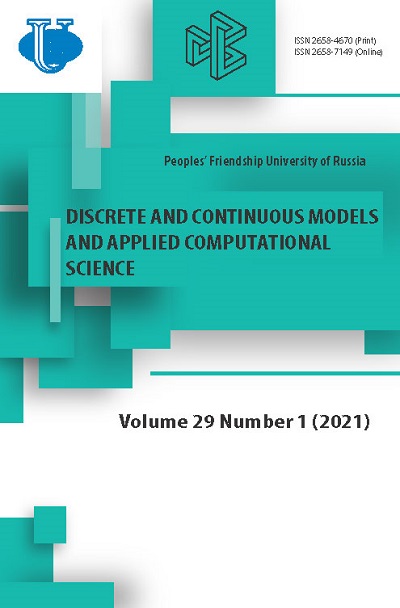Vol 29, No 1 (2021)
- Year: 2021
- Articles: 6
- URL: https://journals.rudn.ru/miph/issue/view/1426
- DOI: https://doi.org/10.22363/2658-4670-2021-29-1
Full Issue
Articles
Numerical simulation of thermal processes occurring in materials under the action of femtosecond laser pulses
Abstract
In this work, a numerical study of the solutions of the parabolic and hyperbolic equations of heat conduction with the same physical parameters is carried out and a comparative analysis of the results obtained is carried out. The mathematical formulation of the problem is discussed. The action of the laser is taken into account through the source function, which was chosen as a double femtosecond laser pulse. In the hyperbolic equation, in contrast to the parabolic one, there is an additional parameter that characterizes the relaxation time of the heat flux. In addition, the source of the hyperbolic equation contains an additional term - the derivative of the power density of the source of the parabolic equation. This means that the temperature of the sample is influenced not only by the power density of the source, but also by the rate of its change. The profiles of the sample temperature at different times and its dynamics at different target depths are shown. The calculations were carried out for different time delays between pulses and for different relaxation parameters.
 5-13
5-13


Normal modes of a waveguide as eigenvectors of a self-adjoint operator pencil
Abstract
A waveguide with a constant, simply connected section is considered under the condition that the substance filling the waveguide is characterized by permittivity and permeability that vary smoothly over the section , but are constant along the waveguide axis. Ideal conductivity conditions are assumed on the walls of the waveguide. On the basis of the previously found representation of the electromagnetic field in such a waveguide using 4 scalar functions, namely, two electric and two magnetic potentials, Maxwell’s equations are rewritten with respect to the potentials and longitudinal components of the field. It appears possible to exclude potentials from this system and arrive at a pair of integro-differential equations for longitudinal components alone that split into two uncoupled wave equations in the optically homogeneous case. In an optically inhomogeneous case, this approach reduces the problem of finding the normal modes of a waveguide to studying the spectrum of a quadratic self-adjoint operator pencil.
 14-21
14-21


Study of the impact of the COVID-19 pandemic on international air transportation
Abstract
Time Series Forecasting has always been a very important area of research in many domains because many different types of data are stored as time series. Given the growing availability of data and computing power in the recent years, Deep Learning has become a fundamental part of the new generation of Time Series Forecasting models, obtaining excellent results.As different time series problems are studied in many different fields, a large number of new architectures have been developed in recent years. This has also been simplified by the growing availability of open source frameworks, which make the development of new custom network components easier and faster.In this paper three different Deep Learning Architecture for Time Series Forecasting are presented: Recurrent Neural Networks (RNNs), that are the most classical and used architecture for Time Series Forecasting problems; Long Short-Term Memory (LSTM), that are an evolution of RNNs developed in order to overcome the vanishing gradient problem; Gated Recurrent Unit (GRU), that are another evolution of RNNs, similar to LSTM.The article is devoted to modeling and forecasting the cost of international air transportation in a pandemic using deep learning methods. The author builds time series models of the American Airlines (AAL) stock prices for a selected period using LSTM, GRU, RNN recurrent neural networks models and compare the accuracy forecast results.
 22-35
22-35


A simulator for analyzing a network slicing policy with SLA-based performance isolation of slices
Abstract
Efficient allocation of radio access network (RAN) resources remains an important challenge with the introduction of 5G networks. RAN virtualization and division into logical subnetworks - slices - puts this task into a new perspective. In the paper we present a software tool based on the OMNeT++ platform and developed for performance analysis of a network slicing policy with SLA-based slice performance isolation. The tool is designed using the object-oriented approach, which provides flexibility and extensibility of the simulation model. The paper briefly presents the slicing policy under study and focuses on the simulator’s architecture and design. Numerical results are provided for illustration.
 36-52
36-52


Optimization of mobile device energy consumption in a fog-based mobile computing offloading mechanism
Abstract
The offloading of computing tasks to the fog computing system is a promising approach to reduce the response time of resource-greedy real-time mobile applications. Besides the decreasing of the response time, the offloading mechanisms may reduce the energy consumption of mobile devices. In the paper, we focused on the analysis of the energy consumption of mobile devices that use fog computing infrastructure to increase the overall system performance and to improve the battery life. We consider a three-layer computing architecture, which consists of the mobile device itself, a fog node, and a remote cloud. The tasks are processed locally or offloaded according to the threshold-based offloading criterion. We have formulated an optimization problem that minimizes the energy consumption under the constraints on the average response time and the probability that the response time is lower than a certain threshold. We also provide the numerical solution to the optimization problem and discuss the numerical results.
 53-62
53-62


On conjugate difference schemes: the midpoint scheme and the trapezoidal scheme
Abstract
 63-72
63-72
















